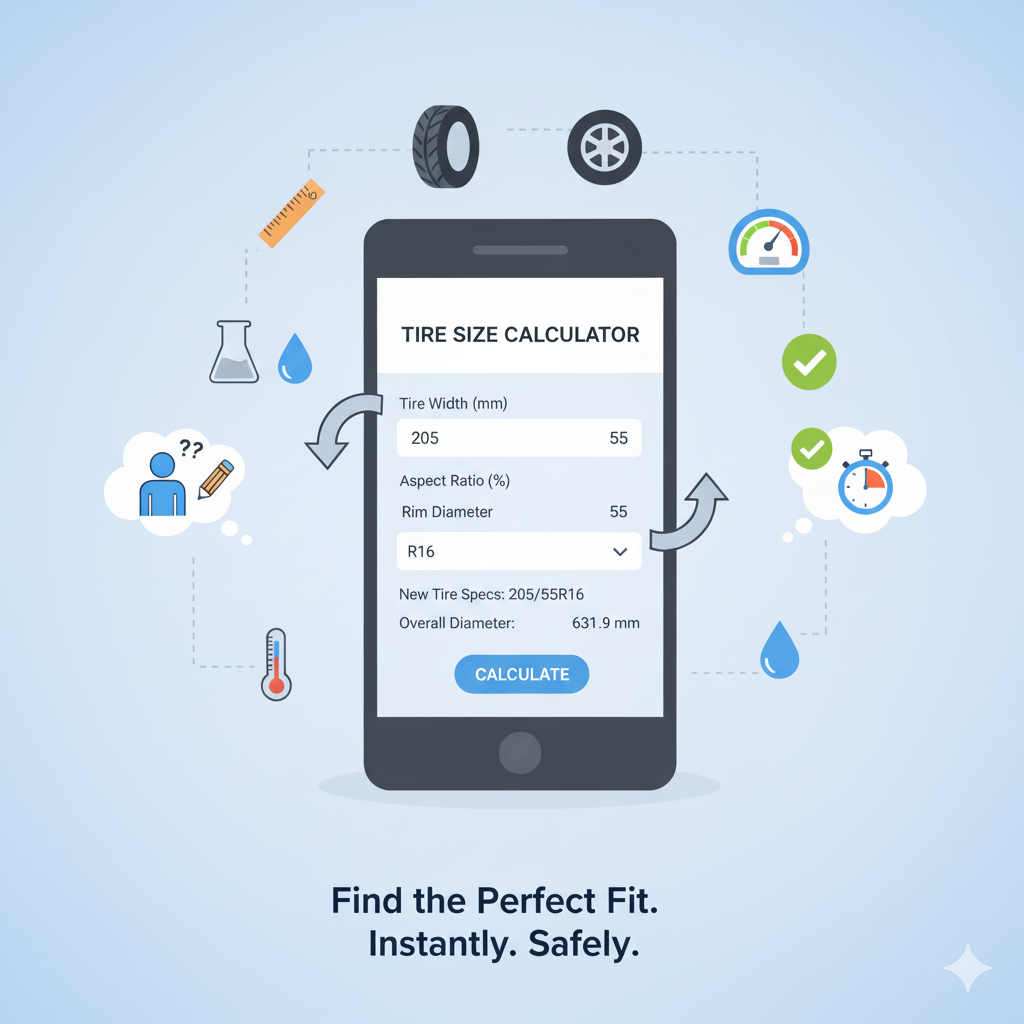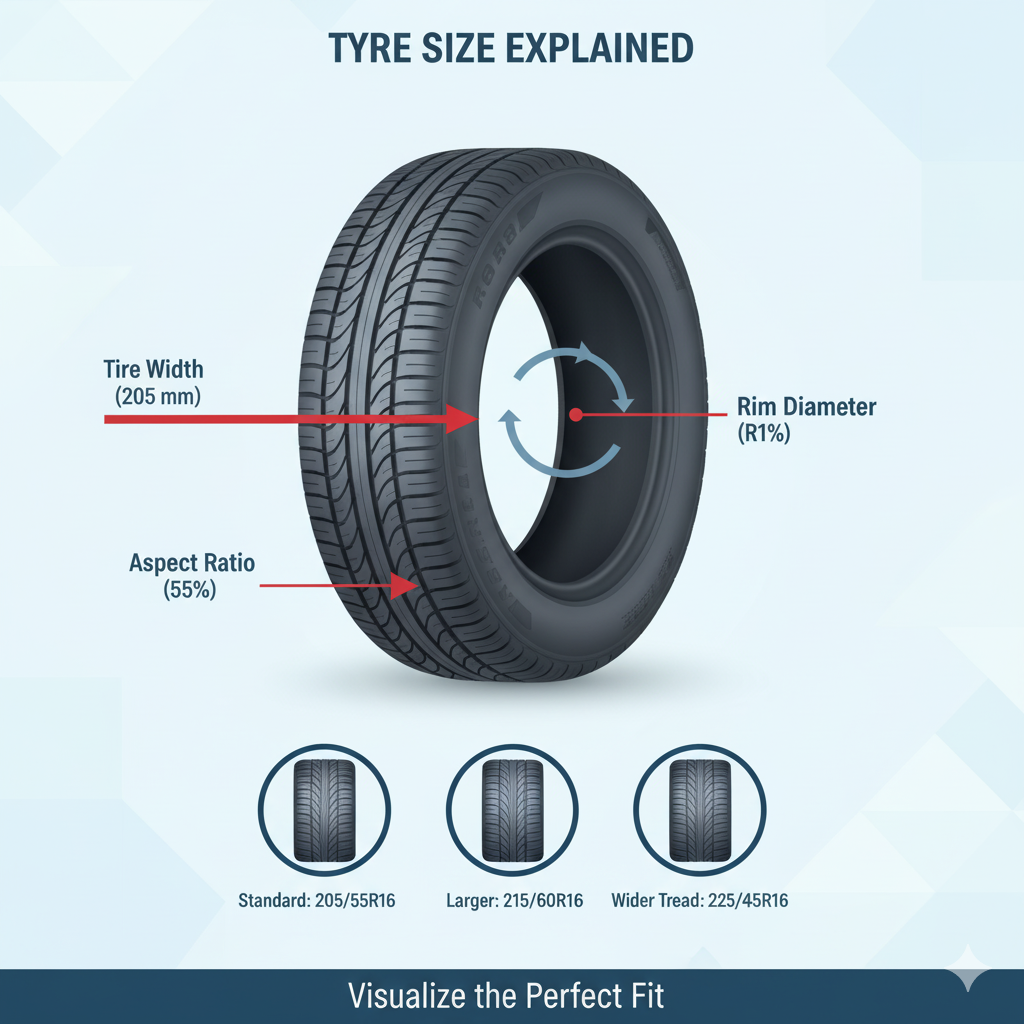Tyre Size Calculator – Find the Perfect Fit for Your Vehicle
Choosing the right tyres for your vehicle is more than just finding something that fits—it's about safety, performance, and efficiency. Our Tyre Size Calculator takes the guesswork out of tyre selection, helping you find compatible sizes, calculate differences, and understand how tyre changes affect your vehicle's performance and instrumentation.
Why Tyre Size Matters More Than You Think
Your tyres are the only point of contact between your vehicle and the road, making their size and specification critically important for:
- Safety: Properly sized tyres maintain vehicle stability and braking performance
- Handling: Correct tyre dimensions ensure optimal steering response and cornering ability
- Fuel Efficiency: The right size reduces rolling resistance and improves mileage
- Speedometer Accuracy: Incorrect tyre sizes can cause speedometer errors up to 10%
- Vehicle Longevity: Properly fitted tyres prevent undue stress on drivetrain components
Key Features of Our Tyre Size Calculator
- Size Compatibility Checking: Verify alternative tyre sizes that fit your vehicle
- Diameter Comparison: Calculate differences between current and potential new tyres
- Speedometer Impact Analysis: See how tyre changes affect your speed reading accuracy
- Rim Width Compatibility: Check which tyre widths work with your existing wheels
- Visual Comparison: Side-by-side size visualization for easy understanding
- Metric/Imperial Conversion: Switch between different measurement systems
- Plus Sizing Guidance: Safe recommendations for upgrading to larger wheels
Who Needs a Tyre Size Calculator?
- Everyday Drivers: Ensuring replacement tyres match OEM specifications
- Car Enthusiasts: Planning wheel and tyre upgrades for performance or appearance
- Off-Road Adventurers: Calculating clearance for larger off-road tyres
- Fleet Managers: Maintaining consistency across multiple vehicles
- Auto Technicians: Verifying tyre specifications during repairs and maintenance
- Used Car Buyers: Checking if existing tyres are properly sized for the vehicle

How to Use Our Tyre Size Calculator: A Step-by-Step Guide
Understanding Tyre Size Notation
Tyre sizes might look confusing, but they follow a logical pattern. For example: 225/45R17 91W
- 225: Section width in millimeters
- 45: Aspect ratio (sidewall height as percentage of width)
- R: Radial construction
- 17: Rim diameter in inches
- 91: Load index (weight capacity)
- W: Speed rating (maximum sustained speed)
Using the Calculator Step-by-Step:
- Enter Current Size: Input your existing tyre size (found on your tyre sidewall)
- Select Alternative Size: Choose a potential new tyre size you're considering
- Compare Specifications: Review the calculated differences in diameter, width, and circumference
- Check Clearance: Ensure there's adequate space in wheel wells for the new size
- Review Speedometer Impact: See how the new size affects your speed reading accuracy
- Verify Load Capacity: Confirm the new tyres meet your vehicle's weight requirements
Real-World Examples: Tyre Size Calculations in Action
Upgrading for Appearance
Current: 205/55R16 → New: 225/45R17
Result: Diameter difference: +0.3% · Speedometer reads 60 mph actual: 60.2 mph · Minimal impact with proper fitment
Off-Road Enlargement
Current: 245/70R16 → New: 265/75R16
Result: Diameter difference: +6.2% · Speedometer reads 60 mph actual: 63.7 mph · Requires suspension modifications
Winter Tyre Sizing
Summer: 225/45R18 → Winter: 205/55R16
Result: Diameter difference: -0.4% · Speedometer reads 60 mph actual: 59.8 mph · Narrower width better for snow traction
Performance Upgrade
Current: 215/60R15 → New: 225/50R16
Result: Diameter difference: +0.9% · Speedometer reads 60 mph actual: 60.5 mph · Improved handling with wider contact patch
Understanding Plus Sizing: The Safe Way to Upgrade
Plus sizing is upgrading to larger wheels while maintaining overall tyre diameter. This improves handling and appearance without affecting speedometer accuracy.
Plus Zero
Keeping the same wheel size with different tyre dimensions. Example: 205/55R16 to 215/50R16
Plus One
Increasing wheel diameter by 1 inch while adjusting tyre profile. Example: 205/55R16 to 225/45R17
Plus Two
Increasing wheel diameter by 2 inches. Example: 205/55R16 to 225/40R18
Important: Always maintain overall diameter within 3% of original equipment for safe operation.
Tyre Size Impact on Vehicle Systems

Speedometer and Odometer
Larger tyres make your speedometer read slower than actual speed. Smaller tyres make it read faster. Our calculator shows exactly how much your readings will be affected.
ABS and Traction Control
Significant size variations can confuse these systems, potentially causing premature activation or reduced effectiveness during emergency maneuvers.
Fuel Economy
Larger, heavier tyres typically reduce fuel efficiency due to increased rolling resistance and weight. Our calculator helps you understand these trade-offs.
Ride Comfort
Lower profile tyres (smaller aspect ratio) typically provide better handling but a firmer ride. Higher profiles offer more comfort but less precise handling.
Related Calculators and Resources
Trip Cost Calculator
Calculate how tyre choices affect your fuel costs on long trips.
Unit Converter
Convert between metric and imperial measurements for international tyre standards.
Frequently Asked Questions
1. How much can I deviate from my original tyre size?
Generally, you should stay within 3% of the original overall diameter. Beyond this, you may experience significant speedometer errors, ABS issues, and potential clearance problems.
2. Can I put wider tyres on my existing wheels?
Most wheels can accommodate tyres up to 20mm wider than original equipment, but you should check your wheel's width range. Our calculator includes rim width compatibility checking.
3. Do I need to recalibrate my speedometer after changing tyre sizes?
For changes under 3%, it's usually not necessary for everyday driving. For larger changes or precision needs, many modern vehicles can be recalibrated using diagnostic tools.
4. How does tyre size affect my vehicle's warranty?
Using tyres within manufacturer specifications won't affect warranty. Extreme deviations that cause component failure might void related warranty claims.
5. Can I mix different tyre sizes on my vehicle?
Generally not recommended, especially on all-wheel drive vehicles where different diameters can damage drivetrain components. Always maintain matching sizes on each axle at minimum.
Find Your Perfect Tyre Fit
Stop guessing and start calculating with confidence. Our Tyre Size Calculator takes the mystery out of tyre selection, ensuring you get the right fit for safety, performance, and efficiency.
Try Our Tyre Size CalculatorFor other automotive calculators, explore our complete automotive section.